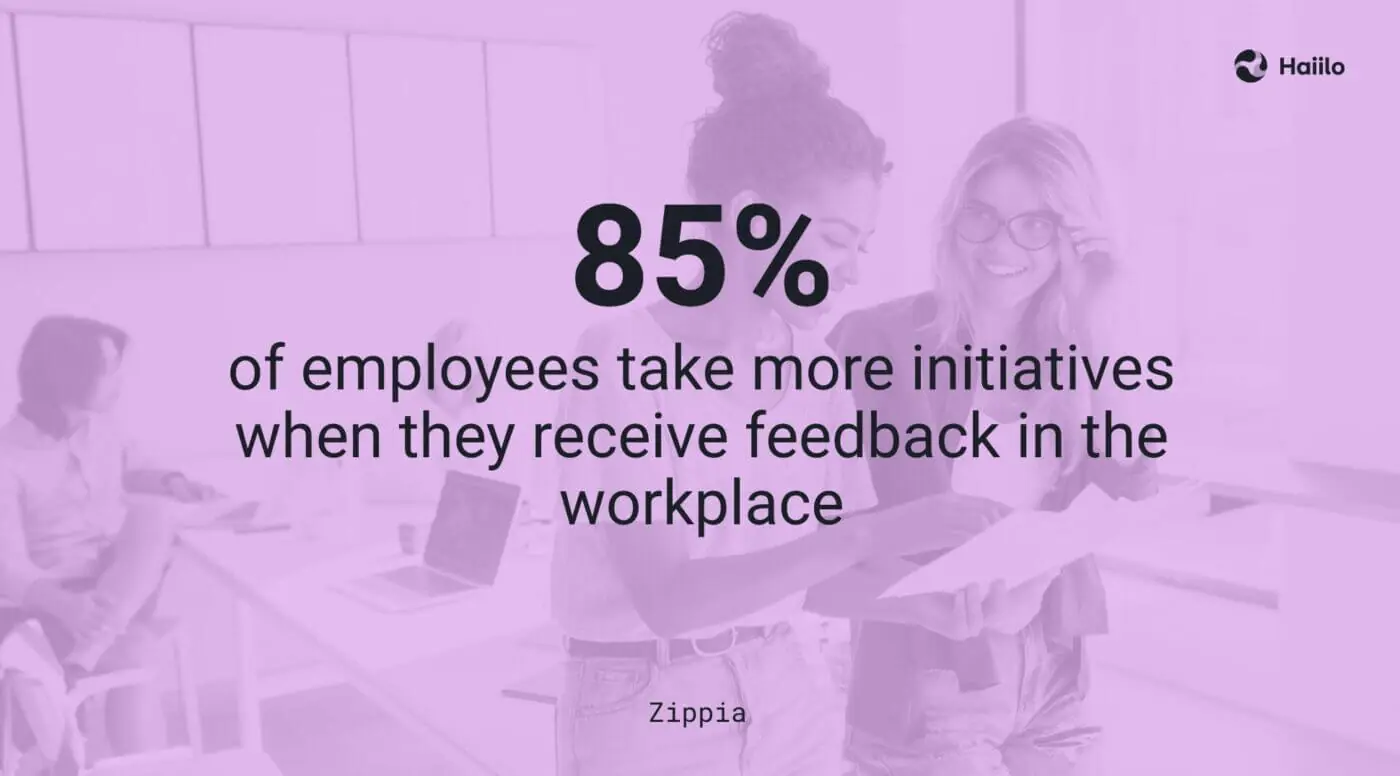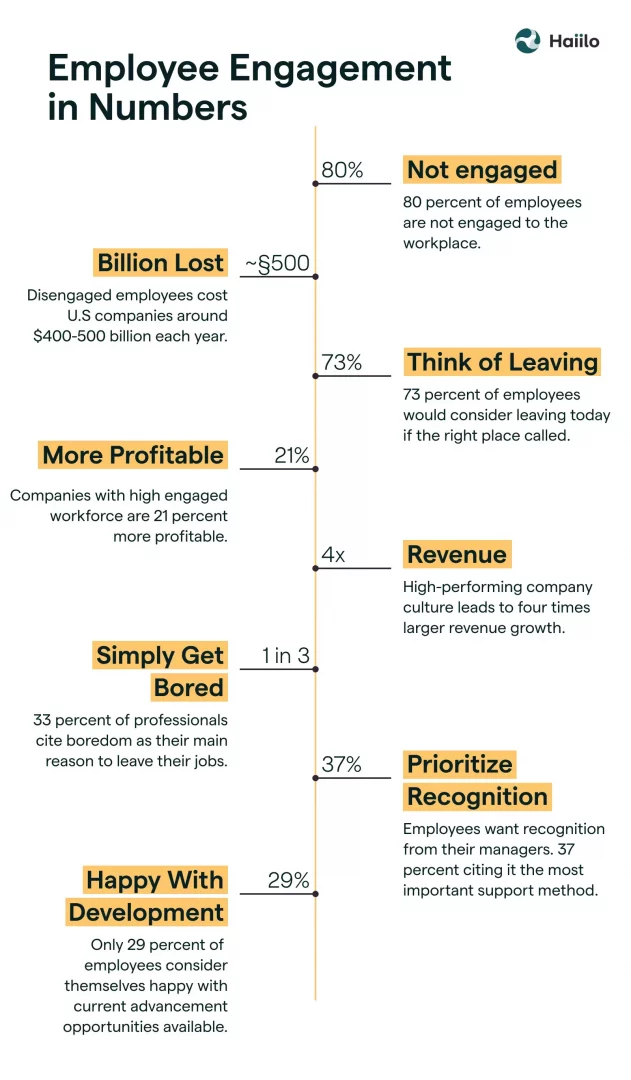To get a better understanding of the current state of employee engagement, we laid out some statistics for those who love numbers.
Employee engagement is the key to building a successful business. But driving employee engagement doesn’t come easy: worldwide, only 20% of employees are engaged with their work. So what went wrong?
Before diving deep into numbers, let’s take a look at the definition of employee engagement and its importance in the workplace.
What Is Employee Engagement?
In today’s fast-changing business environment, retaining top talent is a top challenge for most businesses.
According to research of more than 600 US businesses with 50-500 employees, 63.3% of companies say retaining employees is harder than hiring them.
You’re probably familiar with the “war for talent” concept. Basically, it means that because of the shortage of skills businesses are currently facing and employees’ expectations (they don’t just look at the benefits, they also take into account the company’s values and the development opportunities you offer), it became more challenging for businesses to retain top talent.
Today, more than a third of workers are searching actively or casually for a job. As a result, US employers spend $2.9M per day looking for replacement workers. That’s $1.1B per year. Ouch!
So, what does it take to retain top talent?
In a nutshell, if you want to stay on top of your game and win the “war for talent”, you’ll need to develop an effective employee engagement strategy.
But investing in employee engagement doesn’t mean making your employees happy. Indeed, employee engagement does not mean employee happiness or employee satisfaction. All these concepts are connected, but they are not synonyms!
Think about it: even though your employees are happy with the employee benefits you offer or the work environment, that doesn’t necessarily mean they are engaged with their jobs.

Not all experts and research companies have the same definition of employee engagement. For example:
– Quantum Workplace defines employee engagement as “the strength of the mental and emotional connection employees feel toward their places of work”.
– According to Gallup, engaged employees are “those who are involved in, enthusiastic about, and committed to their work and workplace”.
– According to Willis Towers Watson, employee engagement is “employees’ willingness and ability to contribute to company success”.
– Aon Hewitt defines employee engagement as “the level of an employee’s psychological investment in their organization.”
So, what is employee engagement?
In essence, employee engagement is the emotional commitment the employee has to the organization.
When employees feel engaged, they care about the company and they do their best work to achieve the company’s goals.
When employees are engaged, their #1 objective is to contribute to the company’s success. Employee engagement is not about employee benefits or bonuses, it’s about being part of a successful business.
Drive growth through high levels of employee engagement, with Haiilo.
The Importance of Employee Engagement in the Workplace
As explained earlier, engaged employees do their best work to achieve the business’s goals and they are willing to go the extra mile to contribute to the business’s success.
Employee engagement has become one of the top priorities for most businesses and here’s why:
- Employee engagement increases productivity in the workplace. Engaged employees outperform their peers that are not engaged. Overall, companies with high employee engagement are 21% more profitable.
- Employee engagement improves morale in the workplace.
- Employee engagement reduces absenteeism. In fact, a Gallup study shows that highly engaged workplaces saw 41% lower absenteeism.
- Engaged employees provide a better customer service.
- Low employee engagement is a costly problem! It costs businesses $4,700 on average to hire new talent, and around $986 to onboard the new hire. That means you lose almost $6,000 each time an employee walks out the door, not to mention the unquantifiable cost of losing an experienced employee!
Engaged employees are more efficient and productive. But the majority of the workplace around the world isn’t engaged, and this has serious repercussions for business success!
Therefore, understanding the numbers behind employee engagement is crucial for improving employee engagement initiatives and tactics.
We laid down the most important employee engagement statistics for you to chew on (and remember to scroll all the way down to the bottom of this page to check out the infographic we made with these employee engagement stats 
8 Employee Engagement Statistics You Need to Know
There are hundreds of interesting statistics on employee engagement.
To make things easier for you, we’ve picked top 8 stats you should definitively know about if you want to create an engaging company culture.
Are you ready? Let’s dive in!
1. 85% of Employees Are Not Engaged in the Workplace

According to Gallup’s State of the Global Workplace, only 15 percent of employees are engaged in the workplace.
This means that the majority of the workforce around the world are either viewing their workplace negatively or only doing the bare minimum to make it through the day, with little to no emotional attachment.
The study also reveals remarkable geographical differences – 33 percent of U.S employees are engaged at work – almost two times more than the global average.
On the other hand, in Western Europe, only 10 percent of employees are engaged at work. The situation looks especially alarming in the U.K, where the amount of engaged employees is as low as 8 percent — and the number has been in steady decline for the past few years.
2. 73% of Employees Are Considering Leaving Their Jobs

According to a 2021 study, 73 percent of employees would consider leaving their jobs for the right offer, even if they wouldn’t be looking for a job at the moment.
Changing jobs isn’t all about the money, either, as 86 percent of millennials would accept a pay cut for a chance to work at their ideal job, and 23 percent of those seeking a job wouldn’t need a pay increase to take a new position.
In order to stay on the job, employees need to have relationships with other people in the workplace, and the work life needs to be balanced with their personal life.
Employees are also more likely to look for another job if their co-workers are doing so as well, so companies should be careful of a domino effect taking place in their workforce.
3. Low Employee Engagement Costs Companies $450-500 Billion Each Year

According to a study on workplace engagement in the U.S, disengaged employees cost organizations around $450-550 billion each year.
Disengaged workers take less responsibility and ownership of their attitude, behavior, and motivation, and drain overall productivity.
The study recommends that companies focus on encouraging personal agency and that they use tools to monitor and maintain personal engagement.
It is also important to connect the employees’ job to organizational missions, provide recognition and encourage collaboration.
4. Companies with Highly Engaged Workforce Are 21% More Profitable

Employee engagement isn’t just about soft, intangible and feelings-based reviews about employee well-being.
Employee engagement has a very real impact on business success, and employee engagement should be considered a part of a business strategy.
According to Gallup’s meta-analysis, the business or work units that scored the highest on employee engagement showed 21 percent higher levels of profitability than units in the lowest quartile. Companies with highly engaged workforces also scored 17 percent higher on productivity.
Successful organizations focus on employee engagement by ensuring all employees have the best knowledge and tools available to perform their jobs as well as possible.
Managers in successful organizations also make sure all employees know what is expected of them, and support their employees’ professional development.
Effective communication leads to more productive employees and through this, to a more profitable workplace.
However, we’re not there yet: a recent Interact/Harris Poll shows that 91% of the surveyed employees think that their leaders lack communication skills. What’s more, almost 1 in 3 employees don’t trust their employers, according to the Edelman Trust Barometer. That’s pretty alarming, isn’t it?

5. Good Company Culture Increases Revenue by 4X
In a major long-term study, companies that had the best corporate cultures, that encouraged all-around leadership initiatives and that highly appreciated their employees, customers and owners grew 682 percent in revenue.
During the same period of evaluation — 11 years — companies without a thriving company culture grew only 166 percent in revenue. This means that a thriving company culture leads to more than four times higher revenue growth.
Company culture and employee engagement go hand in hand and a business focusing on employee engagement and improving their company will enjoy the benefits of increased revenue, increased productivity and increased employee engagement.
47 percent of people actively looking for a new job pinpoint company culture as the main reason for wanting to leave, so if you want to improve both employee retention and profitability, improving company culture should be one of your business priorities.
6. 1 in 3 Professionals Cite Boredom as Their Main Reason to Leave Their Jobs

According to a 2018 Korn Ferry Survey, the majority — 33 percent — of those changing jobs cite boredom and the need for new challenges as the top reasons why they are leaving.
The second most common reason was the fact that the work culture didn’t fit the employee or their values, with 24 percent choosing this as their main reason. The quest for a larger salary came fourth, with only 19 percent choosing it as their main reason for leaving.
Making sure employees have enough challenges and variation in their workday is one of the most important managerial tasks. Without the ability to develop themselves and learn, employees lose motivation and start to look elsewhere for a job.
Personal development is naturally good for the company as well, and as employees develop their skills and competencies, their work product becomes more refined and the company becomes more profitable.
7. 37% of Employees Consider Recognition the Most Important

One study asked what would be the most important thing a manager or a company could do that would help the employee be successful and 37 percent — the majority — cited recognition as the most important method of support.
Other solutions lag far behind — 12 percent want more autonomy, 12 percent more inspiration, 7 percent more pay, 6 percent more training, and 4 percent a promotion. This means over a third of the workforce needs first and foremost to be recognized.
According to a survey on rewards and recognition, 43 percent prefer to receive recognition privately on a one-on-one with a manager, 10 percent would prefer to receive recognition publicly in front of their peers, and 9 percent would prefer recognition privately, in written form.
Taking employees for granted is a surefire way to drop down the levels of employee engagement.
Instead, you need to make sure that your employees feel heard and valued. Recognition leads to increased motivation, a sense of pride, and increased self-confidence at work, which in turn increases employee initiative and taking responsibility for one’s own work product.
A recent report shows that 84% of highly engaged employees were recognized the last time they went above and beyond at work compared to only 25% of actively disengaged employees.
A company that actively recognizes and rewards its employees is more likely to see increased levels of accountability, responsibility, and leadership initiatives.

8. Only 29% of Employees Are Happy with Career Advancement Opportunities

According to SHRM’s 2017 Employee Job Satisfaction and Engagement Report, only 29 percent of employees are “very satisfied” with the current career advancement opportunities available to them in the organization they work for.
However, 41 percent consider this a very important factor in job satisfaction, so companies should pay close attention to making sure employees feel they can advance in their careers without leaving the company.
According to the SHRM study, 30 percent of employees considered career development opportunities for learning and personal growth in general very important, yet only 30 percent were happy with their current situation.
The chance for professional development on the job is especially important to the younger generations: according to a Gallup survey, up to 87 percent of Millennials consider development in a job important.
The importance of professional development to employee engagement is undeniable, and managers and HR personnel need to provide tools and resources to support their employees’ professional development.
9. 85% of employees take more initiative when they receive feedback in the workplace

According to Zippia study:
- 85% of employees take more initiative when they receive feedback in the workplace
- 73% of employees are better collaborators when they receive feedback in the workplace
- 48% of employees care more about their work when they receive feedback in the workplace
Managers should always follow the best employee feedback practices to drive higher engagement in the workplace. Feedback must be timely, relevant, and constructive.
Also, leaders must encourage bottom-up feedback as well.
10. Diverse and inclusive organizations work 12% harder, are 19% more likely to stay longer with the organization and collaborate 57% more effectively with peers

Diversity and inclusion initiatives help employees develop a sense of belonging. Furthermore, they improve trust in the workplace and the overall employee experience.
As nicely put by one of the DEI experts:
One of the most important ways to show employees that you respect their backgrounds and traditions is to invite them to share those characteristics of their cultures in the workplace…it is the inclusion that connects people to the business, and we believe it’s one of the core reasons they stay-because they have been able to find their place where they belong. Belonging goes beyond DEI; it is essential in optimizing employee engagement and commitment.
Employee Engagement Stats [Infograhic]

The Impact of Remote and Hybrid Work On Employee Engagement
In the past few years, many employees had to adopt new ways of working and cope with sudden new work arrangements in no time. They had to cope with information overload, making it challenging for them to spot real and fake news. They also got concerned about their health and jobs as the number of layoffs skyrocketed during the pandemic.
However, many employees prefer flexible ways of work as they help them have a better work-life balance, and boost their morale and motivation.

Here are a few key employee engagement statistics related to remote and hybrid work:
- According to the Quantum Workplace report published in August 2021, in the past 18 months, hybrid workers have had the highest employee engagement rate (81%). Fully remote workers, on the other hand, have a 78% engagement rate while on-site employees have the least high engagement levels with 72%.
- According to Owl Lab’s 2022 State of Remote Work Report, 62% (around two-thirds) of workers feel more productive when working remotely, while only 11% feel less productive (they say this is because there are more distractions).
- 69% of remote employees are burnt out. Despite this, 59% of remote workers are still failing to take enough time off and 42% are not planning to take any time off.
- According to a Remote co survey of 200 full-time remote workers, 40% of respondents believe unplugging after work hours is the biggest challenge remote workers face.
- The majority of professionals (44%) find collaborating in the office more productive than the 22% who find collaborating remotely more productive.
- Remote employees experience a higher level of job satisfaction than on-site workers. The value of this to productivity becomes apparent when we consider a study by the Harvard Business Review which revealed that employees who are satisfied with their jobs are 31% more productive.
The Role of Internal Communications in Employee Engagement
The very first thing you need to take a look at when it comes to improving employee engagement is your internal communication.

Indeed, your internal communication strategy is one of the key drivers of employee engagement.
When a company has a great internal communications strategy in place, employees feel more informed, secure and motivated to achieve the company’s goals.
What’s more, effective internal communications lower frustration in the workplace, which is strongly connected with employee engagement.
Think about it: the typical knowledge worker spends 2.5 hours a day searching for information. When key information is missing, employees need to look for it by themselves. They end up browsing their Intranets and G-Drives for hours and calling their colleagues for help.
At the end of the end, poor internal communication leads to employee frustration and lower productivity in the workplace. So, before you start planning your next employee engagement strategy, start with your internal communication!






